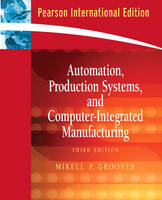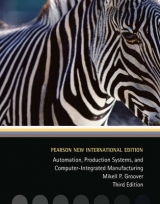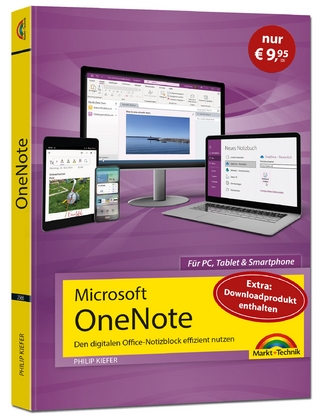
Automation, Production Systems, and Computer-Integrated Manufacturing
Pearson (Verlag)
978-0-13-207073-7 (ISBN)
- Titel erscheint in neuer Auflage
- Artikel merken
This exploration of the technical and engineering aspects of automated production systems provides the most advanced, comprehensive, and balanced coverage of the subject of any text on the market. It covers all the major cutting-edge technologies of production automation and material handling, and how these technologies are used to construct modern manufacturing systems.
MIKELL P. GROOVER is Professor of Industrial and Manufacturing Systems Engineering at Lehigh University, where he also serves as Director of the Manufacturing Technology Laboratory. He holds the following degrees all from Lehigh: B.A. (1961) in Arts and Science, B.S. (1962) in Mechanical Engineering, M.S. (1966) and Ph.D. (1969) in Industrial Engineering. He is a Registered Professional Engineer in Pennsylvania (since 1972). His industrial experience includes full-time employment at Eastman Kodak Company as a Manufacturing Engineer. Since joining Lehigh, he has done consulting, research, and project work for a number of industrial companies including Ingersoll-Rand, Air Products & Chemicals, Bethlehem Steel, and Hershey Foods. His teaching and research areas include manufacturing processes, metal cutting theory, automation and robotics, production systems, material handling, facilities planning, and work systems. He has received a number of teaching awards, including the Albert Holzman Outstanding Educator Award from the Institute of Industrial Engineers (IIE). His publications include over 75 technical articles and papers which have appeared in Industrial Engineering, IIE Transactions, NAMRC Proceedings, ASME Transactions, IEEE Spectrum, International Journal of Production Systems, Encyclopaedia Britannica, SME Technical Papers, and others. Professor Groover's avocation is writing textbooks on topics in manufacturing and automation. His previous books are used throughout the world and have been translated into French, German, Korean, Spanish, Portuguese, Russian, Japanese, and Chinese. His book Fundamentals of Modern Manufacturing received the 1996 IIE Joint Publishers Award and the 1996 M. Eugene Merchant Manufacturing Textbook Award from the Society of Manufacturing Engineers. Dr. Groover is a member of the Institute of Industrial Engineers, American Society of Mechanical Engineers (ASME), Society of Manufacturing Engineers (SME), and North American Manufacturing Research Institute (NAMRI). He is a Fellow of IIE and SME.
chapter 1 Introduction
1.1 Production Systems
1.2 Automation in Production Systems
1.3 Manual Labor in Production Systems
1.4 Automation Principles and Strategies
1.5 Organization of the Book
Part I Overview of Manufacturing chapter 2 Manufacturing Operations
2.1 Manufacturing Industries and Products
2.2 Manufacturing Operations
2.3 Production Facilities
2.4 Product/Production Relationships
2.5 Lean Production
chapter 3 Manufacturing Models and Metrics
3.1 Mathematical Models of Production Performance
3.2 Manufacturing Costs
Appendix A3 Averaging Procedures for Production Models
Part II Automation and Control Technologies
chapter 4 Introduction to Automation
4.1 Basic Elements of an Automated System
4.2 Advanced Automation Functions
4.3 Levels of Automation
chapter 5 Industrial Control Systems
5.1 Process Industries Versus Discrete Manufacturing Industries
5.2 Continuous Versus Discrete Control
5.3 Computer Process Control
chapter 6 Hardware Components for Automation and Process Control
6.1 Sensors
6.2 Actuators
6.3 Analog-to-Digital Converters
6.4 Digital-to-Analog Converters
6.5 Input/Output Devices for Discrete Data
chapter 7 Numerical Control
7.1 Fundamentals of NC Technology
7.2 Computer Numerical Control
7.3 Distributed Numerical Control
7.4 Applications of NC
7.5 Engineering Analysis of NC Positioning Systems
7.6 NC Part Programming
Appendix A7 Coding for Manual Part Programming
Appendix B7 Part Programming with APT
chapter 8 Industrial Robotics
8.1 Robot Anatomy and Related Attributes
8.2 Robot Control Systems
8.3 End Effectors
8.4 Sensors in Robotics
8.5 Industrial Robot Applications
8.6 Robot Programming
8.7 Robot Accuracy and Repeatability
chapter 9 Discrete Control Using Programmable Logic Controllers and Personal Computers
9.1 Discrete Process Control
9.2 Ladder Logic Diagrams
9.3 Programmable Logic Controllers
9.4 Personal Computers Using Soft Logic
Part III Material Handling and Identification Technologies chapter 10 Material Transport Systems
10.1 Introduction to Material Handling Equipment
10.2 Material Transport Equipment
10.3 Analysis of Material Transport Systems
chapter 11 Storage Systems
11.1 Storage System Performance and Location Strategies
11.2 Conventional Storage Methods and Equipment
11.3 Automated Storage Systems
11.4 Engineering Analysis of Storage Systems
chapter 12 Automatic Identification and Data Capture
12.1 Overview of Automatic Identification Methods
12.2 Bar Code Technology
12.3 Radio Frequency Identification
12.4 Other AIDC Technologies
Part IV Manufacturing Systems chapter 13 Introduction to Manufacturing Systems
13.1 Components of a Manufacturing System
13.2 Classification of Manufacturing Systems
13.3 Overview of the Classification Scheme
chapter 14 Single-Station Manufacturing Cells 14.1 Single Station Manned Workstations
14.2 Single Station Automated Cells
14.3 Applications of Single Station Cells
14.4 Analysis of Single Station Cells
chapter 15 Manual Assembly Lines 15.1 Fundamentals of Manual Assembly Lines
15.2 Analysis of Single Model Assembly Lines
15.3 Line Balancing Algorithms
15.4 Mixed Model Assembly Lines
15.5 Workstation Considerations
15.6 Other Considerations in Assembly Line Design 15.7 Alternative Assembly Systems
chapter 16 Automated Production Lines 16.1 Fundamentals of Automated Production Lines
16.2 Applications of Automated Production Lines
16.3 Analysis of Transfer Lines
chapter 17 Automated Assembly Systems
17.1 Fundamentals of Automated Assembly Systems
17.2 Quantitative Analysis of Assembly Systems
chapter 18 Cellular Manufacturing
18.1 Part Families
18.2 Parts Classification and Coding
18.3 Production Flow Analysis
18.4 Cellular Manufacturing
18.5 Applications of Group Technology
18.6 Quantitative Analysis in Cellular Manufacturing
chapter 19 Flexible Manufacturing Systems
19.1 What is a Flexible Manufacturing Systems?
19.2 FMS Components
19.3 FMS Applications and Benefits 19.4 FMS Planning and Implementation Issues
19.5 Quantitative Analysis of Flexible Manufacturing Systems
PART V Quality Control in Manufacturing Systems
chapter 20 Quality Programs for Manufacturing
20.1 Quality in Design and Manufacturing
20.2 Traditional and Modern Quality Control
20.3 Process Variability and Process Capability
20.4 Statistical Process Control
20.5 Six Sigma
20.6 The Six Sigma DMAIC Procedure
20.7 Taguchi Methods in Quality Engineering
20.8 ISO 9000
chapter 21 Inspection Principles and Practices
21.1 Inspection Fundamentals
21.2 Sampling vs. 100% Inspection
21.3 Automated Inspection
21.4 When and Where to Inspect
21.5 Quantitative Analysis of Inspection
chapter 22 Inspection Technologies
22.1 Inspection Metrology
22.2 Contact vs. Noncontact Inspection Techniques
22.3 Conventional Measuring and Gaging Techniques
22.4 Coordinate Measuring Machines
22.5 Surface Measurement
22.6 Machine Vision
22.7 Other Optical Inspection Techniques
22.8 Noncontact Nonoptical Inspection Technologies
Part VI Manufacturing Support Systems chapter 23 Product Design and CAD/CAM in the Production System
23.1 Product Design and CAD
23.2 CAD System Hardware
23.3 CAM, CAD/CAM, and CIM
23.4 Quality Function Deployment
chapter 24 Process Planning and Concurrent Engineering
24.1 Process Planning
24.2 Computer-Aided Process Planning
24.3 Concurrent Engineering and Design for Manufacturing
24.4 Advanced Manufacturing Planning
chapter 25 Production Planning and Control Systems
25.1 Aggregate Production Planning and the Master Production Schedule
25.2 Material Requirements Planning
25.3 Capacity Planning
25.4 Shop Floor Control
25.5 Inventory Control
25.6 Extensions of MRP
chapter 26 Just-In-Time and Lean Production 26.1 Lean Production and Waste in Manufacturing
26.2 Just-In-Time Production Systems
26.3 Autonomation
26.4 Worker Involvement
| Erscheint lt. Verlag | 24.4.2008 |
|---|---|
| Sprache | englisch |
| Maße | 203 x 246 mm |
| Gewicht | 1285 g |
| Themenwelt | Mathematik / Informatik ► Informatik |
| Technik ► Maschinenbau | |
| ISBN-10 | 0-13-207073-1 / 0132070731 |
| ISBN-13 | 978-0-13-207073-7 / 9780132070737 |
| Zustand | Neuware |
| Haben Sie eine Frage zum Produkt? |
aus dem Bereich



